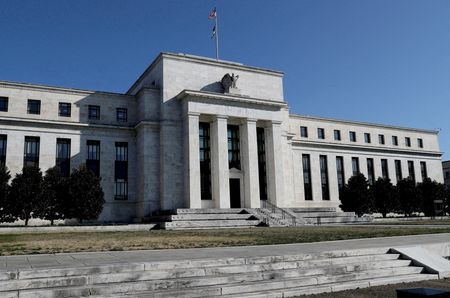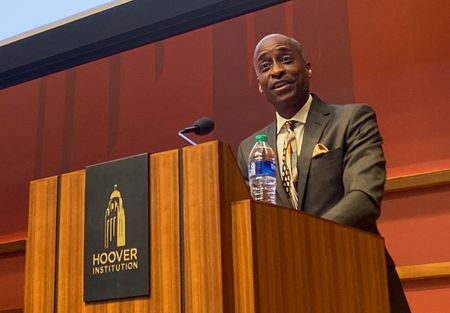By Ann Saphir
PALO ALTO, Calif. (Reuters) -The Federal Reserve is getting interest rates closer to where they need to be to win the battle against inflation, a pair of U.S. central bankers said on Friday, though neither gave a clear signal on whether they feel they have reached that point.
Coming a week after Fed policymakers raised their target range for the benchmark rate to 5%-5.25%, the remarks – from Fed Governor Philip Jefferson and St. Louis Fed President James Bullard — suggest some uncertainty about whether the Fed will in fact pause interest-rate hikes next month, as is widely expected.
Indeed a third U.S. central banker speaking early in the day, Governor Michelle Bowman, signaled she feels further policy tightening may yet be appropriate, unless inflation drops more convincingly.
The Fed has raised its benchmark interest rate five full percentage points over the past 14 months – the fastest pace of tightening in 40 years.
Inflation by the Fed’s preferred measure has eased from 7% last summer to 4.2%.
Meanwhile unemployment, which had been expected to rise as borrowing costs surged, has instead fallen to 3.4%, the lowest since 1969.
“Is inflation still too high? Yes,” Fed Governor Philip Jefferson said at a monetary policy conference at the Hoover Institution. “Has the current disinflation been uneven and slower than any of us would like? Yes. But my reading of this evidence is that we are ‘doing what is necessary or expected’ of us,” which is the dictionary definition, he said, of being “on track.”
At the same time, Jefferson did not ring any victory bells, offering the observation that little recent progress on core inflation, particularly in services inflation, is “bad news.” In April, core U.S. consumer prices — stripping out volatile gas and food prices – rose 5.5% after advancing by 5.6% in March.
The Fed targets 2% inflation.
Jefferson’s remarks may draw particular attention after he was nominated earlier in the day by U.S. President Joe Biden to be the next Fed vice chair, a key role in shaping U.S. monetary policy.
Fed Chair Jerome Powell signaled the central bank may pause further rate hikes as it assesses the impact of its past tightening, as well as the effect of recent bank sector stress on lending and credit.
Jefferson on Friday said he feels “the full effects of our rapid tightening are still likely ahead of us,” and his current view is that the string of regional bank failures probably will have only a mild tightening effect on credit conditions. He did not give his views on a possible pause.
PRETTY GOOD PROSPECTS
St. Louis Fed President James Bullard, who spoke at the same conference, said that he finds “encouraging” the recent stablization of inflation expectations near the Fed’s 2% target, adding, “the prospects for continue disinflation are pretty good.”
That’s notable from a policymaker who was among the first and most vocal to push for sharp rate hikes to fight inflation, back in mid-2021.
But since then, he said, the Fed’s rate hikes have helped bring down what had been a worrying rise in inflation expectations that, if left unchecked, could have sent actual inflation spiraling out of control.
“Monetary policy is now at the low end of what is arguably sufficiently restrictive given current macroeconomic conditions,” he said.
And yet he said, “the bad news for the hawks in the room is, you are barely in the zone” of restrictive-enough policy.
The Fed next meets to set interest rates June 13-14.
(Reporting by Ann SaphirEditing by Shri Navaratnam)






